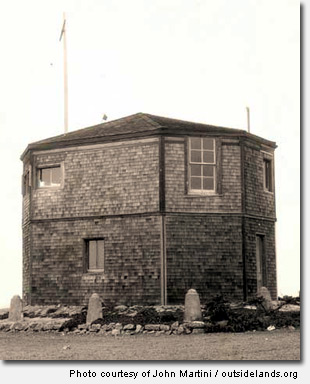 Janice over at the Sunset Style blog opened my eyes to a landmark in my own backyard that I didn’t even know about: an octagon building at Land’s End.
Janice over at the Sunset Style blog opened my eyes to a landmark in my own backyard that I didn’t even know about: an octagon building at Land’s End.
Nestled and barely visible in the trees above the Land’s End parking lot, the building was once the Point Lobos Marine Exchange Lookout Station. Completed in 1927, the station’s mandate was to watch for approaching ships and announce their arrival to the Embarcadero where stevedores, tug boats, taxis and drayage companies waited to unload the cargo or transport passengers.
It’s a long way between Land’s End and the Embarcadero, so how did they do it? Signals were sent to the Embarcadero via a semaphore system. The Point Lobos station would adjust its signal arms to represent the type of ship approaching and then send the signal. After viewing it via telescope, another station atop Rob Robb Hill in the Presidio would then relay the signal onto a hill called Loma Alto, later known as Telegraph Hill.
In addition to watching for approaching ships for commercial reasons, the lookout station also kept an eye out for vessels in distress in the crowded Golden Gate waters.
To find out more about the lookout, check out the excellent article on its history on outsidelands.org. The article was just posted this month and closes by saying that “plans are being developed for the unique building’s preservation and future reuse”.
Head over to Sunset Style to see some pictures of what the lookout station looks like today.
I’ll definitely have to search this one out the next time I’m out at Land’s End. Have any of you come across it?
Sarah B.
Yep, certainly have… It was inhabited until a few years ago by Mrs. Morrissey, a widow who married to lookout. The semaphore on top is almost covered by the trees now, but was once visible all the way to the Presidio. It was Mr. Morrissey who was the last person who saw–from land, as she was anchoring–the SS “City of Rio de Janeiro” before she sank in early 1901 around Fort Point.
I have an old photo showing the lookout station, and what is now the parking lot, surrounded by trash and smoking garbage, as it was before it became a national park property.